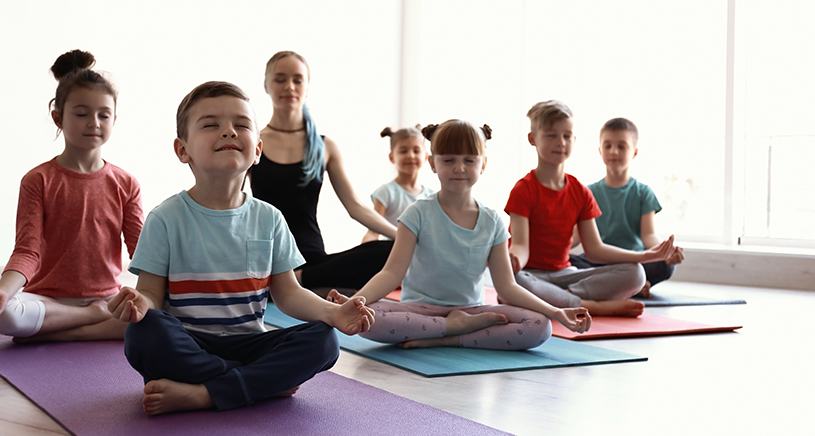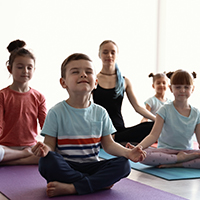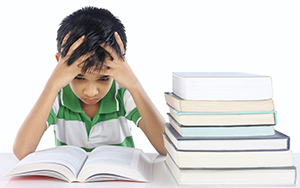Meditation for Children
 |
| Meditation for Children |
| By Chahna Tailor |
| With the world moving so rapidly, it has become possible to provide future generations with more than our parents or grandparents could have even dreamed. Children are being exposed to so many things at an earlier and earlier age: news bytes, celebrities, sports, music, among a variety of other subjects.
We all know that learning does not start at school; it starts at home. A child’s first teacher is their parent/guardian – they learn by watching and listening to the people around them. They learn by mimicking facial and other gestures. A child may not know whether an action they witness is right or wrong – they simply copy them. When a similar situation occurs, they will likely copy that action because it has already been associated as the correct response. Hence, when their parental figure accidentally slips and bangs their fudging toe, their child has just learned what a fudging toe is.
Children have stressful lives too. That may seem like an oxymoron, right? With such a small number of years on this planet, how could their experience of life be stressful already? Well, as their guardians, we are always trying to ensure a balanced life for them. In addition to school grades, we involve them in many extracurricular activities. We ensure they are eating healthy, getting enough sleep, and are not overly stimulated. Unfortunately, even a balanced life can create stressors. On top of that, add siblings, friends, and other family members, and one can easily see how stress can creep into even the youngest members of our family. It is natural to worry about our children’s well being. However, are we paying the same level of attention to their mental health? What outlets are we providing for them to process stress in a healthy manner? Meditation can help a child develop: • Self-awareness Meditation can help a child learn how to take time for themselves and tune out from their daily pressures in a healthy way.
Self-regulation skills include not giving into our first reaction such as anger or sadness. It helps keep us from getting distracted by our surroundings and also helps us to continue performing the task which we were originally involved in. All around the world, including here in the United States, some schools have integrated yoga coupled with meditation and pranayama breathing techniques as an elective class. Some schools are offering the same as a part of the after-school program curriculum. One school in Baltimore was recently recognized for offering their students a small room called the Mindful Moment Room to re-energize, re-balance, and ground themselves! The Dalai Lama said, “If every 8 year old in the world is taught meditation, we will eliminate violence from the world within one generation.” An environment that is conducive to meditation is an environment in which a child can thrive on creating a meaningful and sustainable practice. The ability to employ these skills in the moment can become a learned reaction through practice. The best way to encourage a child to establish a practice is by being a role model. By watching meditation being consistently performed by their parents, children will respect the method and techniques. We have become ever-conscious about what we give our kids when it comes to foods and stimuli. But, bringing up a generation of mindful human beings that are in tune with themselves and teaching them to combat negative emotional responses is as important, if not even more so. By modeling meditation to our children, we are not only teaching our future generation to be more loving and compassionate to themselves, but we are also giving them the gift of mindfulness from our own practice. |
|
Chahna Tailor is a certified yoga instructor with backgrounds in occupational therapy and health science. Occupational therapy opened up the doors of knowledge when it came to taking care of the Self first and leading a healthier life. This led her to the physical practice of yoga. Chahna deepened her practice by training in Rishikesh, India, where she studied the science behind yoga, the breath, and meditation. Chahna also practices personal training, Reiki, hypnotherapy, aromatherapy, pranichealing, and sound healing. |



 Similarly, they learn to process stress through watching others around them. A person that takes the time out of their schedule to input relaxation and recover in a healthy manner can pass on these techniques to their child naturally. A person that keeps themselves in a constant state of anxiety and does not employ proper stress reduction techniques can pass on those behaviors as well. At the end of the day, whatever you do will rub off onto your children.
Similarly, they learn to process stress through watching others around them. A person that takes the time out of their schedule to input relaxation and recover in a healthy manner can pass on these techniques to their child naturally. A person that keeps themselves in a constant state of anxiety and does not employ proper stress reduction techniques can pass on those behaviors as well. At the end of the day, whatever you do will rub off onto your children. Did you know that schools around the country are now starting to offer meditation to replace the practice of detention? This gives the child an opportunity to reflect on their actions and move forward in a positive manner. This self-regulation of one’s mental state during a stressful situation is very beneficial. One of the definitions of self-regulation is, “the ability to monitor and control our own behavior, emotions, or thoughts, altering them in accordance with the demands of the situation” (www.education.com).
Did you know that schools around the country are now starting to offer meditation to replace the practice of detention? This gives the child an opportunity to reflect on their actions and move forward in a positive manner. This self-regulation of one’s mental state during a stressful situation is very beneficial. One of the definitions of self-regulation is, “the ability to monitor and control our own behavior, emotions, or thoughts, altering them in accordance with the demands of the situation” (www.education.com). About the Author
About the Author

























